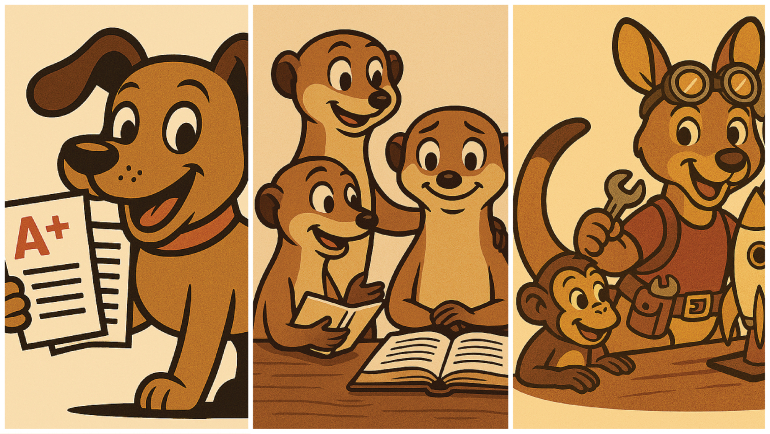By Bronwen Williams, Danielah Martinez, Dr Haider Akmal
Published 29 September 2025
Confident, brave, collaborative and intrinsically motivated: These are the attributes we desire our design students to take into their careers and lives.
However, the attributes we commonly see in our first-year cohorts when they arrive are anxious, conservative, competitive and extrinsically motivated. Graded assessments contribute significantly to this mindset for new-to-university students (Kohn, 2013). Competency-based assessment (CBA), where learners demonstrate proficiency across specific skills according to benchmarks, has been receiving increasing attention in tertiary education as a way to reduce students’ stress and cultivate a growth mindset (Dweck, 2016).
In Term 1 2024, we applied CBA through a satisfactory/unsatisfactory fail (SY/UF) grading system in the first-year core design studio course, FADA1010. This course had previously used UNSW’s standards-based grading (SBG) system of a letter grade and numerical score (e.g., CR, 70). To better understand the student experiences of CBA, we surveyed the students in both 2024 and 2025.
We thematically analysed the data to capture the complex relationship between the students’ overall response to CBA and the degree to which they experience positive impacts across our four identified foundational attributes of wellbeing, creative risk-taking, collaboration and motivation, which are central to professional design practice.
Our observations of the data highlighted that for most students, CBA has a positive impact in these four areas of foundational skills and personal attributes (Kunrath et al., 2020), particularly for students who experience stress under SBG systems.
A limitation of our dataset is the low response rate; around 10% of enrolled students (N=447). It is likely that those who responded had particularly strong opinions or experiences, which may have skewed the data and limit the degree to which it represented the broader cohort. However, we still feel that the results offer interesting and useful insights about CBA.
From the student feedback, we derived three personas, which creatively interpret and communicate how different learner types respond to CBA, highlighting both its benefits and limitations. Personas are design thinking tools that represent a “fictional yet data-driven description of a ... typical user” (Allabarton, 2024). For this research, they are used to identify patterns in the data (Dam & Siang, 2025), and reflect on how these trends might capture the diversity of both positive and negative experiences of CBA within the cohort. The personas presented below are an aggregate of the raw data shown in the spider graphs, along with our interpretation of this data combined with qualitative responses from students. It’s important to note that these personas hold spectrums of experiences and are indicative of sentiment, rather than representative of a specific student. In addition, these personas are processed through our perspective as the convenors and tutors of this cohort who have specific goals for curriculum design.
The Gradehound
The first persona, The Gradehound, strongly prefers an SBG system and desires a numerical mark. This student has existing academic literacy and communicates a desire to be recognised for their capabilities. As this student is extrinsically motivated, CBA does not have a positive impact on this attribute. Similarly, this persona reports minimal stress when receiving marks and is typically already confident in their abilities upon entering university; therefore, CBA has a neutral impact on their wellbeing and collaboration. Gradehound personas tend to undervalue risk-taking, despite their apparent aptitude, perhaps because the benefits are unclear when the risk does not explicitly contribute to their results in the form of higher marks in CBA.
The Peerkat
The second persona, The Peerkat, enters university with high anxiety around the assessment of their performance and receiving marks. They are highly motivated to simply meet minimum course requirements and therefore exhibit extremely low risk-taking. CBA supports this type of student by alleviating stress and anxiety around achieving certain grades, reflected in the extremely positive wellbeing experiences. Improved wellbeing unlocks students’ potential to focus on course content, skill building and collaboration, and drives them to be more intrinsically motivated. In our view, this cohort is the one that benefits the most from CBA, although more needs to be done to encourage their creative risk-taking.
The Tinkeroo
The third persona, The Tinkeroo, thrives under CBA and most positively embodies the graduate attributes we aim to cultivate. This group embraces collaboration, supported by the reduced perception of competition in CBA, with students reporting strong peer-to-peer support. Risk-taking is the highest value for this cohort, compared to the Gradehound and Peerkat personas, indicating significantly more creative confidence (Kelley & Kelley, 2013). Motivation for this group is largely intrinsic, and wellbeing is also generally high, but both areas include some complexity. Nonetheless, CBA enables this student to grow into a confident, brave, collaborative and intrinsically motivated creative practitioner.
Our research has led us to identify the benefits and limitations of CBA through the creative lens of these personas that capture the student experience. They show us that, on the whole, CBA reduces stress and provides opportunities for students to take creative risks and engage deeply within a collective learning experience.
However, to fully realise its potential, especially for extrinsically motivated students, we must explore additional motivational strategies that are relevant to industry but separate from assessment.
With promising results already evident, we are inspired to refine our approach to CBA and map possible ways of supporting these personas in the classroom.
****
Reading this on a mobile? Scroll down to learn about the authors.



